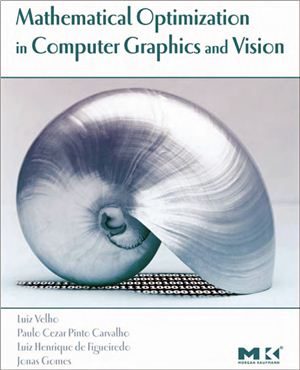Издательство Elsevier/Morgan Kaufmann, 2008, -300 pp.
Mathematical optimization has a fundamental importance in solving many problems in computer graphics and vision. This fact is apparent from a quick look at the SIGGRAPH proceedings and other relevant publications in these areas, where a significant percentage of the papers use mathematical optimization techniques.
The book provides a conceptual analysis of the problems in computer graphics and discusses the mathematical models used to solve these problems. This motivates the reader to understand the importance of optimization techniques in graphics and vision.
The book gives an overview of combinatorial, continuous, and variational optimization methods, focusing on graphical applications. The prerequisites for the book are (i) background on linear algebra and calculus of one and several variables; (ii) computational background on algorithms and programming; and (iii) knowledge of geometric modeling, animation, image processing, image analysis, and visualization.
This book originated from a set of notes in Portuguese that we wrote for a course on this topic at the BrazilianMathematical Colloquium in July 1999 and at Brazilian Congress of AppliedMathematics in October 2000. After that, these notes were expanded and translated to English. This material was then presented in two highly successful SIGGRAPH tutorial courses in August 2002 and 2003.
Mathematical optimization is vast and has many ramifications, encompassing many disciplines ranging from pure mathematics to computer sciences and engineering. Consequently, there exists a vast literature on this subject, including textbooks, tutorials, and research papers that cover in detail practically every aspect of the field. The sheer amount of information available makes it difficult for a nonspecialist to explore the literature and find the right optimization technique for a specific application.
From the comments above, it becomes apparent that any attempt to present the whole area of mathematical optimization in detail would be a daunting task, probably doomed to failure. This endeavor would be even more difficult if the goal is to understand the applications of optimization methods to a multidisciplinary and diversified area such as computer graphics.
The objective of this book is to give an overview of the different aspects of mathematical optimization to enable the reader to have a global understanding of the field and pursue studies of specific techniques related to applications in graphics and vision. Since mathematical optimization is so pervasive in graphical applications, we decided to present in detail only the seminal techniques that appeared in early papers. The more recent research is discussed in a section at the end of every chapter devoted to comments and references. This section also includes pointers to the literature.
The book is conceptually divided into five parts: computer graphics and optimization; variational and continuous optimization; combinatorial optimization; global optimization methods; and probability and optimization.
Computer Graphics
Optimization: An Overview
Optimization and Computer Graphics
Variational Optimization
Continuous Optimization
Combinatorial Optimization
Global Optimization
Probability and Optimization
Mathematical optimization has a fundamental importance in solving many problems in computer graphics and vision. This fact is apparent from a quick look at the SIGGRAPH proceedings and other relevant publications in these areas, where a significant percentage of the papers use mathematical optimization techniques.
The book provides a conceptual analysis of the problems in computer graphics and discusses the mathematical models used to solve these problems. This motivates the reader to understand the importance of optimization techniques in graphics and vision.
The book gives an overview of combinatorial, continuous, and variational optimization methods, focusing on graphical applications. The prerequisites for the book are (i) background on linear algebra and calculus of one and several variables; (ii) computational background on algorithms and programming; and (iii) knowledge of geometric modeling, animation, image processing, image analysis, and visualization.
This book originated from a set of notes in Portuguese that we wrote for a course on this topic at the BrazilianMathematical Colloquium in July 1999 and at Brazilian Congress of AppliedMathematics in October 2000. After that, these notes were expanded and translated to English. This material was then presented in two highly successful SIGGRAPH tutorial courses in August 2002 and 2003.
Mathematical optimization is vast and has many ramifications, encompassing many disciplines ranging from pure mathematics to computer sciences and engineering. Consequently, there exists a vast literature on this subject, including textbooks, tutorials, and research papers that cover in detail practically every aspect of the field. The sheer amount of information available makes it difficult for a nonspecialist to explore the literature and find the right optimization technique for a specific application.
From the comments above, it becomes apparent that any attempt to present the whole area of mathematical optimization in detail would be a daunting task, probably doomed to failure. This endeavor would be even more difficult if the goal is to understand the applications of optimization methods to a multidisciplinary and diversified area such as computer graphics.
The objective of this book is to give an overview of the different aspects of mathematical optimization to enable the reader to have a global understanding of the field and pursue studies of specific techniques related to applications in graphics and vision. Since mathematical optimization is so pervasive in graphical applications, we decided to present in detail only the seminal techniques that appeared in early papers. The more recent research is discussed in a section at the end of every chapter devoted to comments and references. This section also includes pointers to the literature.
The book is conceptually divided into five parts: computer graphics and optimization; variational and continuous optimization; combinatorial optimization; global optimization methods; and probability and optimization.
Computer Graphics
Optimization: An Overview
Optimization and Computer Graphics
Variational Optimization
Continuous Optimization
Combinatorial Optimization
Global Optimization
Probability and Optimization

